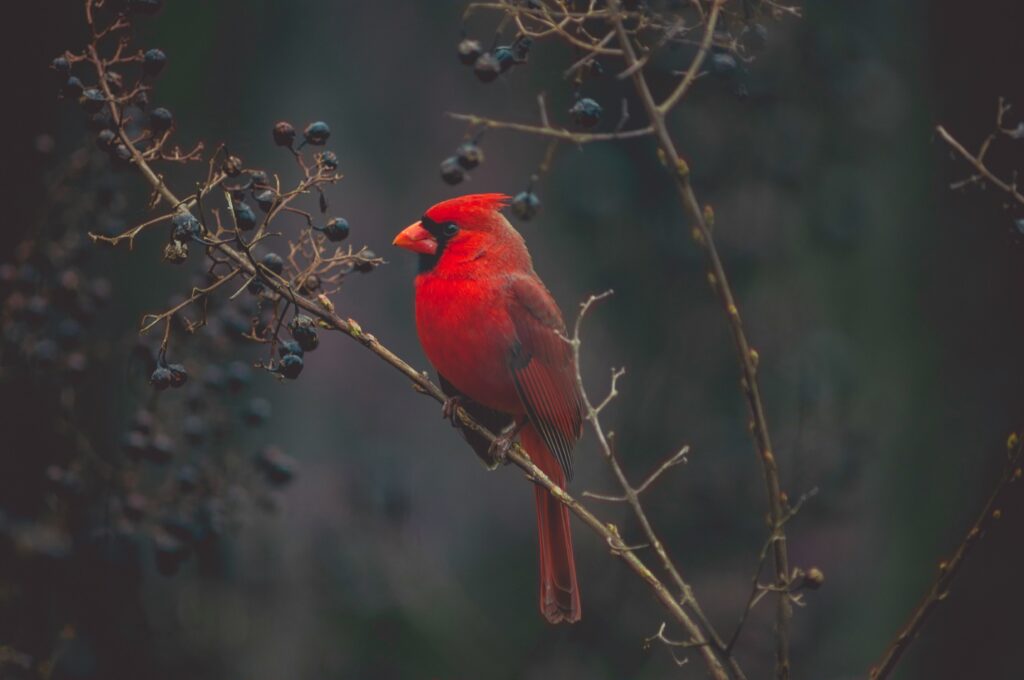Cardinals in Midwinter
A flash of red! What cheer! What cheer!
Warmer days will soon be here!
The cardinal sings, our spirits soar.
Spring is certainly at the door
Standing outside in the pre-dawn light, shovel in hand, I sigh. The snow is still falling and once again, I have to clear the fluffy white stuff before I can move on with the day. I begin with a sweep down the middle of my driveway and then work to clear each side. Thankfully the snow is light and the lifting is easy. The rhythm of shoveling is soothing for me as I match my breath to each push. This is a dance I have honed to perfection over the years. In its own way it brings me peace.
I pause to admire the winter snow-globe scene that surrounds me. I breathe in the fresh, crisp air. Still early twilight, I listen intently, and then, as I had hoped, there it is! The first song of the morning! The first tangible sign that spring really is on its way. “What cheer! What cheer!” sings the northern cardinal (Cardinalis cardinalis). I smile, take another deep breath and continue with my task, serenaded by this vibrant bird.

Many folks are enamored with the cheerful, red feathered cardinal. Its appearance at the feeder always gladdens the heart, just like an old friend.
Cardinals seem to magically appear in the dusky, crepuscular times of day. Arriving as a twilight diner allows them to eat with less competition and be less conspicuous to predators, such as cats.
Unlike some of their feeder colleagues that travel larger areas as winter feeding flocks, (think juncos and chickadees) northern cardinals tend to stay in the same smaller territory and are a regular in the neighborhood. This allows them to know where the local grocery stores of black sunflower and safflower seeds are, which makes travel time to food much easier and quicker.

Cardinals are found in many yards throughout the eastern half of North America. They prefer places with hedges, forest edges and low growing shrubs for cover and nesting habitat. As mostly ground feeders, having a dense tangle of branches and vines nearby can make for an easy exit should a cat or Cooper’s hawk appear on the scene.
The brilliant red tones of the male and warm red tinged brown of the female make them an excellent study for beginning birders. Because they don’t molt into a duller plumage they are easy to spot all year round. They have a large, orange, pliers shaped beak that allows them to crush the seeds that make up the bulk of their diet. This adaptation puts them in the category of granivorous or grain eating birds along with sparrows, buntings, goldfinches, and grosbeaks. Both male and female cardinals have a prominent crest at the top of their heads. This is another great field mark to look for.

Many people attribute symbolism or meaning to particular animals. The cardinal is no exception. For many people the cardinal is a symbol of:
- Spiritual messaging – Cardinals are seen as a purveyor of messages from the spirit world. The old saying goes, “when cardinals appear, angels are near.”
- Wealth and prosperity – Certain Native American cultures, such as Cherokee Culture, believe the cardinal can be a sign of good luck
- Devotion and home – Cardinals do not migrate, stay together for life, and work together to build the nest and take care of their young.
- Music – Both male and female cardinals sing and have a repertoire of over 28 different vocalizations.
At the end of the day (or the beginning!) cardinals are flashy and feisty, fun to watch, and a balm for our winter weary spirits. Go outside at dawn or dusk and wait for the unmistakable “What cheer! What cheer!” It is sure to bring a smile to your face and joy to your heart.

Attend an upcoming event with Lynette as your guide! Visit our events page for more information.